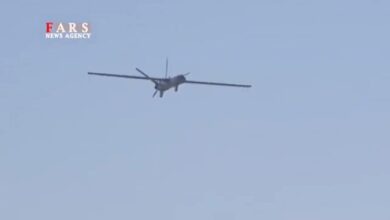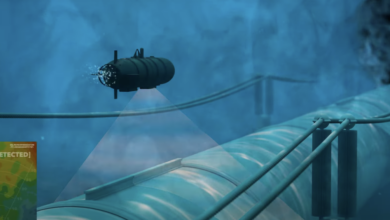Rheinmetall unveils autonomous Mission Master UGV armed with Warmate combat drone
Tube-launched swarming loitering munitions latest addition to modular Mission Master autonomous UGV
Rheinmetall has announced a new addition to its modular Mission Master autonomous unmanned ground vehicle system – multiple tube-launched Warmate loitering drone munitions.
Germany-headquartered Rheinmetall partnered with Poland’s WB Group to integrate the Warmate micro combat unmanned air vehicle on its 8×8 all-terrain Mission Master – Protection UGV variant, to enhance combat effectiveness by providing dismounted troops with both observation and precision strike capabilities, the company said in a September 3 release.
The new system was presented at MSPO 2019, the 27th International Defence Industry Exhibition in Kielce, Poland.
The Warmate UAV is capable of scanning the battlefield to detect and engage the enemy. The 1.2 m (46 inch) long UAV has an operating range of 10 km and a flight time of around 30 minutes, and can be fitted with a range of heads. All the heads come with surveillance capabilities, but some include a fragmentation charge or a shaped fragmentation charge, and a laser-seeking warhead is an option. WB Group pitches the Warmate as a longer-range alternative to anti-tank guided missile systems.
If an attack is aborted, the drone can continue loitering, be directed to another target, or be recalled, depending on configuration.
The Warmate provides a video feed to the operator, and while the majority of flight phases are fully automated, the system requires operator input to arm the drone and execute a combat task.
Rheinmetall said the new Mission Master – Protection can also use the Warmate in beyond line-of-sight swarm attacks, dramatically increasing combat power, and an accompanying image showed six tube launchers fitted to the vehicle.
“Being able to observe hidden targets and conduct precise identification before initiating a surgical strike with minimal collateral damage is a real tactical advantage on today’s battlefield,” said Alain Tremblay, Rheinmetall Canada’s vice-president for business development.
Tremblay noted that both the Mission Master and the Warmate “are able to conduct certain autonomous operations,” reducing the number of personnel required and enabling troops to “focus on mission success.”
Operators can direct both the UGV and UAV from a ground control station, a soldier system such as Rheinmetall Argus, or with Rheinmetall Command and Control Software.
Mission Master autonomous 8×8 unmanned ground vehicle
Rheinmetall’s modular Mission Master UGV is designed to support dismounted troops by providing logistics, surveillance, protection, medical evacuation and communication relay among other capabilities.
Powered by lithium-ion batteries, its electric drive can endure for up to eight hours at up to 30 km/h (19 mph) carrying payloads of up to 600 kg (1,300 lb) on land for up to 200 km, or carry 300 kg in water at 5 km/h, although an optional auxiliary power unit significantly increases endurance.
It can be controlled by an operator, while in semi-autonomous pre-programmed, ‘follow-me’ and convoy modes, and fully autonomous mode use its onboard Lidars to identify and avoid or negotiate obstacles.
Tremblay said Mission Master is expected to achieve fully autonomous initial capability by early 2020, Janes reported.
A customer-tailored system can be designed based on the Cargo, Rescue, Surveillance or Protection variants.
Using Rheinmetall’s Fieldranger remote weapons station, the armed Mission Master – Protection version can be fitted with a range of weapons systems, including a 7.62 mm machine gun, 20 mm high velocity cannon, and 30 and 40 mm automatic grenade launchers. In December last year, the company was working on integrating Northrop Grumman’s M230 LF 30 mm chain gun and EuroSpike missiles.
In March, Rheinmetall demonstrated a Mission Master – Protection variant equipped with two Thales FZ220 7-tube 70mm rocket launchers at the Ammunition Capability Demonstration in South Africa. The system fired a 14-rocket salvo, delivering 60 kg of explosives in 1.6 seconds. The NATO-qualified system can fire rockets with high explosive or high-explosive anti-tank warheads, with a range of 2 km for direct fire, 7 km for indirect fire, or 9 km if guided rockets are employed.












